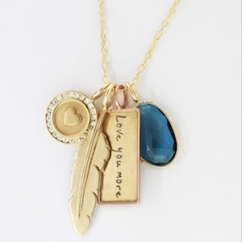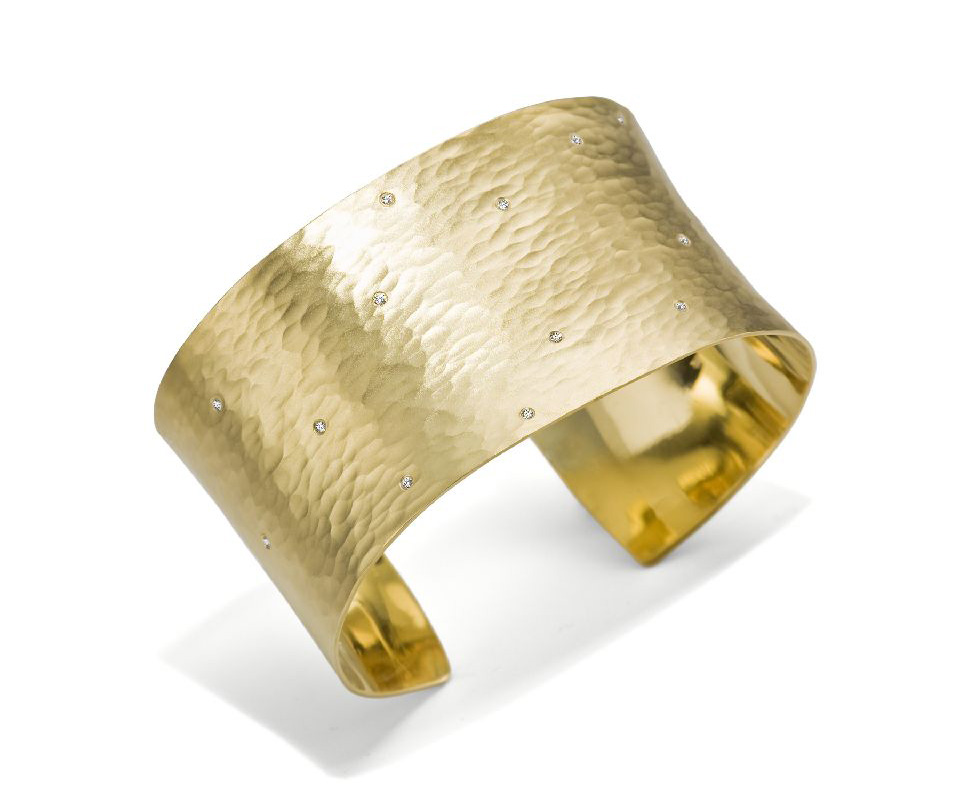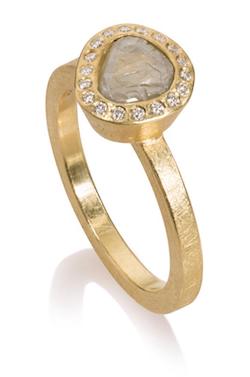Articles and News
Recycled Gold Can Be A Competitive Edge If The Brand Story Is Compelling | August 23, 2017 (1 comment)

New York, NY—Can recycled metals become a competitive advantage for luxury jewelers? Will consumers pay more for it?
Absolutely, says Stewart Grice of Richmond, VA-based refiners Hoover & Strong, which first got into recycled gold because jewelry designer and customer Toby Pomeroy—a leader in its use—asked about it. Recycled gold is now a big part of Hoover & Strong’s business, and the company has further ventured into fair-mined and fair-trade gold.
At left, a charm necklace from Cleveland, OH-based designer Heather Moore, whose personalized message designs are hand-created using recycled precious metals.
Grice was one of a panel of experts discussing recycled and fair-trade metals as a competitive advantage during the recent Initiatives In Art & Culture Gold Conference in New York City. In addition to Grice, the discussion included Lindsey Rubin of Republic Metals, Miami, FL; Ted Doudak of Riva Precision Jewelry Manufacturing, New York, NY; and Linus Drogs of Au Enterprises, Berkley, MI. It was moderated by Andrea Hill, former CEO of Rio Grande and owner Chicago-based Hill Management Group.
“Toby asked a question and it became a movement,” explained Hill. Today, responsible jewelry practices are almost expected of jewelers, she says. “It’s not something people bring to you, it’s something you bring to yourself. If you wait, you’re not being part of the conversation,” she cautioned.


"Eclipse" necklace and a gold cuff sprinkled with diamonds in recycled gold, by Toby Pomeroy.
“It made us masters of our own destiny, said Grice. “We could take all the scrap materials and make our parts.” Because Hoover & Strong is relatively small compared to other refineries, it also can refine specific gold for individual consumers as well.
Republic Metals also can refine and return a customer’s own gold, said Rubin, but on a larger scale, the company no longer wants to purchase from mining aggregators.
“In South Africa, you find all these aggregators, but if we can’t audit our client and their clients and follow that metal from ground to refinery, we don't want to take a risk.” The company’s gold production now stands at about 50/50 scrap to mined; silver is 80/20, she said.
Cost and willingness to change are stumbling blocks for jewelers up and down the supply chain. Recycled and fair-trade gold adds cost, which jewelers worry customers may not be willing to pay and salespeople may not be willing to sell.
Republic’s decision can impact profits, Rubin acknowledged, but she says the way to address it is through the brand story and adapting to increasing democratization of brands.
“We asked what we could do to come back from cutting millions of dollars in profit. We came up with the term ‘peace of mined,’ taking from publicly traded mines or recyclable streams, and refining in separate batches to give the consumer peace of mind and responsible sourcing. We use a hydrochemical process my late father invented in 1985. It’s something we’ve always done but now we take advantage of it.
“So much of the news diminishes consumer and investor faith in precious metal. It might cost you a little bit of money to change that, but if you can elevate your brand it’s worth it,” she continued. “‘Peace of Mined’ was adapting to the market, and like Hoover & Strong who were pioneers in recycled streams, there’s no price you can put on your own peace of mind.”


Recycled metals and sustainably sourced gemstones are central to Colorado-based designer Todd Reed's brand story, which also celebrates the jewelry's American-made pedigree. Left, a gold and diamond necklace; right, a modern solitaire engagement ring featuring Reed's signature "raw" diamonds.
Jewelers and manufacturers may also have to deal with employee pushback. Hoover & Strong’s Grice said his salespeople “latch onto anything new like a tick on a dog,” but convincing long-term employees why they had to do things a new way was harder. “In 2007, when there was a lot of dialogue about dirty gold, [owner] Tory Hoover said, ‘we have to change. We have to do this differently.’ Now it’s a company-wide ethic and people sit in the boardroom talking about karma,” he laughed.
Linus Drogs simply doesn’t give AU Enterprises’ customers an alternative. He sells mostly recycled gold, and some new fair-mined gold. “Some of our clients’ focus is fair-mined gold, so we supply that for them, but more and more clients [in general] are asking ‘where do your materials come from?’”
Cost is a concern, but prices are coming down. “More and more companies are working with recycled material so it's more competitive. Fair-mined material is pricey, but if you really want to know where it came from, from the stream to the source to in the box, you have that ability,” said Drogs.
Hill addressed a common worry for jewelers: if they push one product as ethically sourced, doesn’t it imply their other products aren’t?
No, because customers expect everything to be ethically sourced, said Doudak. “The customer doesn't want to pay for properly sourced metal, they want to get it as part of the service. Responsible sourcing is not starting at the refiner. Down to the bench we need to acknowledge there's a long chain of responsibility and the only way we can succeed in creating confidence in our product is acknowledging the full chain.” That in turn makes it easier for retailers to stock recycled gold and create a niche for themselves, he added.

Cynthia Ann's Ancient Medals collection is another take on repurposed jewelry.







